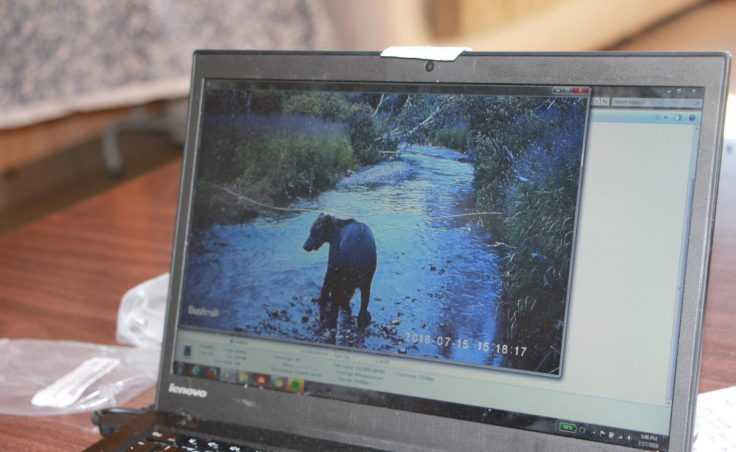Researchers with the Alaska Salmon Program have found a way to study bears when they come to fish in Happy Creek or any other salmon stream in Bristol Bay: with cameras activated by movement, and barbed wires to snag bear hair.
For the past several years, University of Washington’s Fisheries Research Institute researchers have been studying what happens upstream from a slightly different perspective as part of a multi-decade study of Bristol Bay salmon: the bears’.
The goal is to figure out how many bears there are, and what impact they have on the salmon swimming back upstream – based on when, where and even how they’re eating them – and how bears move throughout the region.
The set-up is relatively simple, if a little time-intensive. Six streams, each with barbed wire stretched across it in two spots to snag bear hair as they go by. Researcher Aaron Wirsing said the set-up plays on the natural behavior of bears.
“The stream is the path of least resistance and has all their food in it, so … they move up and down the streams, which means if we span a string of barbed wire across, we have a good chance of snagging hair for most of the bears that are on these streams,” he said.
That hair is used for genetics testing to ID the bears. At each of the wires, there’s a motion-activated camera. Some of the streams also have an extra camera, to see more of the bear action.
Wirsing is a researcher based for the summer at UW’s Fisheries Research Institute. The group has studied bear predation and its impacts on salmon for more than a decade. In 2010, they decided to use cameras to see what bears were up to when humans weren’t around. Since then, they’ve added genetics, to get a unique ID for the bears.
“Since 2012, not including this year, we’ve detected over 120 different bears, just on six streams,” he said. “That’s just detected, so we can use those numbers to actually estimate how many bears actually use these streams.”
It takes an hour or so to check the traps on Happy Creek and marvel at the sheer number of salmon swimming upstream to spawn. On a normal day, the team checks traps on three of the six streams they’re studying.
The protocol is relatively simple: any hair caught by the barbed-wire is carefully removed with sterilized equipment, and put into a labeled bag with the number of the wire it was caught on. On one July day, while Wirsing and a research technician work on collecting those, colleague Anne Hilborn checks the camera part of the trap.
“One of the nice things about being able to match up the wires and the cameras is the cameras are kind of an independent check of whether the wires work,” Wirsing said. “So if we photograph a bear near the wire, does it leave hair? In most cases it does. So I think the wires do a very good job of detecting a bear, if you will, if it’s in the area.”
The cameras are adjustable, and Hilborn has changed how sensitive they are and how long they record to try and get the best bear imagery. Sometimes, other animals show up: moose, porcupines, fox, a mink, and lots of birds. But mostly, there are lots of clips to go through of just the stream, Hilborn said.
“A heavy day will be several hundred clips, of which maybe four or five will have bears on them, and the rest is branches and grass and things,” Hilborn said. “And we actually found on this creek that the salmon are setting off the camera, so we’ve got 600 clips of salmon going up the creek as well. Which actually could provide a bunch of interesting information about when the salmon actually first come in, what direction they go, ‘cause sometimes they go back out for a while.”
Despite those potential salmon studies, the project remains focused on bears for now, although it is expanding in area – the Alaska Salmon Program has sites at Lake Nerka, too – and collaborators with the Fish and Wildlife Service and Alaska Department of Fish and Game are working on other sites in Wood Tikchik and Dillingham, as well.
Each day after the traps are checked, the cameras are watched back at the FRI Bunkhouse on Lake Aleknagik. When a bear shows up in a clip, it provides an array of information: the research team can figure out when a barbed wire went down, and watch bears go fishing. Some of the bears are repeat visitors that Hilborn said the team recognizes. Other vary more. The clips also offer another glimpse into the reality of Bristol Bay’s salmon streams, Hilborn said.
“One of the things about the camera traps, is it shows you exactly how many bears are here, in the exact same places we’re walking,” she said. “It’s a little sobering sometimes. Because the photos are time-stamped, you can see the bears, and then you see us come out, and then you see more bears come in.”


